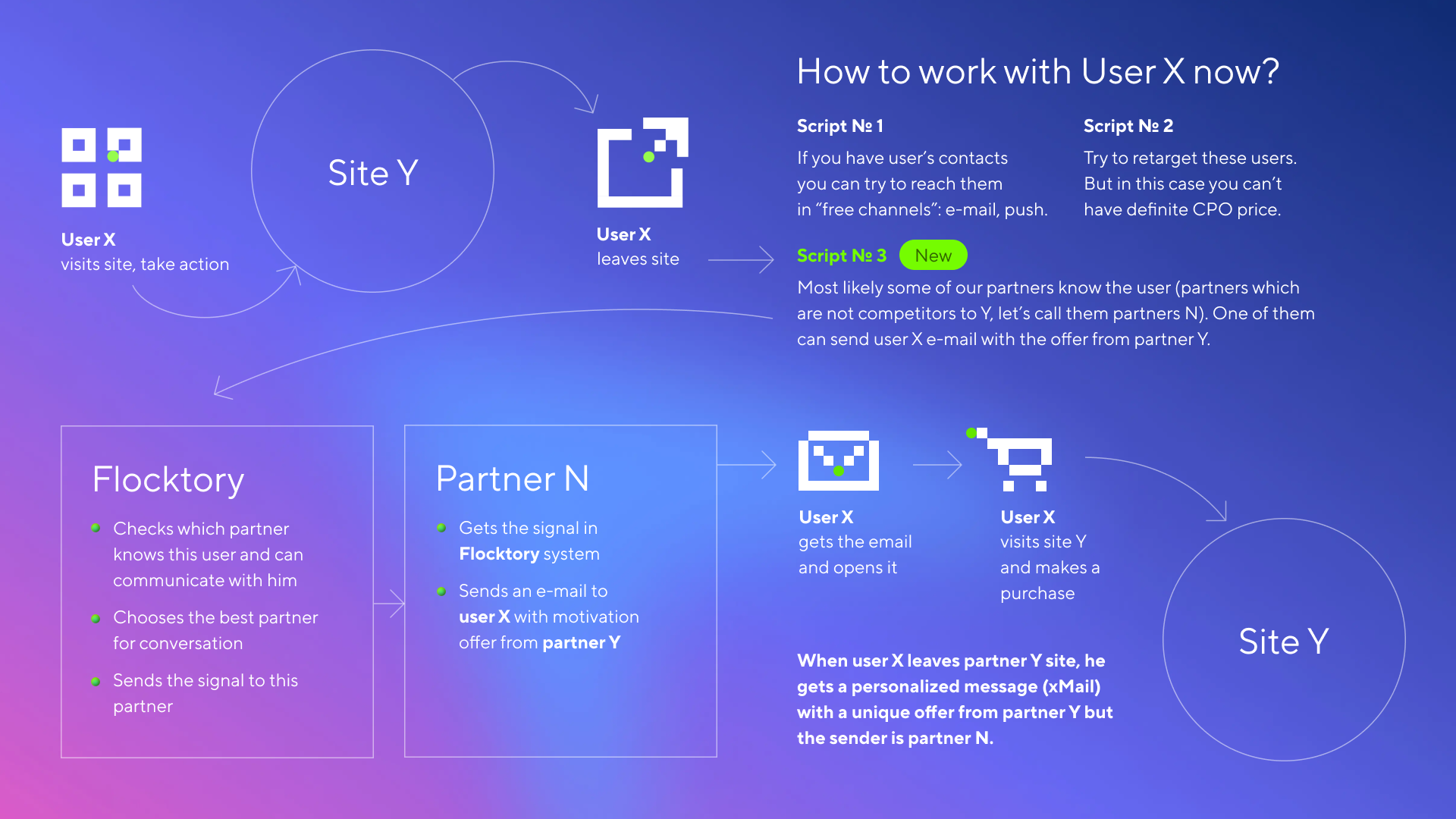Flocktory: How to Attract an Audience in a New Reality
As major sites and platforms have suspended their activities in Russia, the issue of effective allocation of funds is relevant like never before for many companies. The Flocktory team offers two performance tools (the tools’ MAU is 50,000,000 people) that have already proven themselves in the market, and which will help advertisers solve several problems: attract new consumers, return lost customers, and also work effectively with the current CRM database. We are talking about two Flocktory solutions: xMail and Exchange.
What xMail is, what problems it solves, and how it works
XMail refers to affiliate mailings or, more simply, email retargeting. This tool enables you to reach interested users who visited your site, but did not leave any contact details (email address, phone number, consent to a push subscription).
The xMail tool makes it possible to both work with new users and reactivate dormant ones, and it can thus solve several problems at once:
- to increase the number of orders;
- to attract new customers;
- to reactivate dormant customers;
- to increase the loyalty of your current base.
It’s best to explain the essence of the module work using an example: imagine that user X (for whom you’ve already paid, since there is no free traffic) enters the site of partner Y, performs a certain action there, then leaves the site without buying anything (to the marketing specialist’s disappointment).
The toolkit of that same marketing specialist implies two scenarios for working with this user:
- Try to catch up with the user via shareware channels, such as e-mail or push, if we have the user’s contact details and permission to communicate with them.
- Try to catch up with this user via retargeting, although this scenario does not guarantee that we will not exceed the set CPO rate, and in the current market situation, retargeting opportunities are quite limited due to the withdrawal of large advertising systems.
But there is a third scenario.
This user will likely be known to a number of Flocktory partners (non-competitors of partner Y, let’s call them partners N), who will be able to send the user an email on their behalf with a message from partner Y.
In real-time, the platform checks available senders, compliance with configured conditions and receiving audiences, and frequency limits, and also determines the sender with the highest potential conversion, taking into account the product category. For example, if a user viewed dog food on the website of a pet supplies retailer, the email will be sent by the Flocktory partner whose audience is most effectively converted in the pet supplies category (although this partner’s activities are not related to this category).
And now, after user X has left the site of partner Y, user X receives a personalized message (xMail) with a unique offer from partner Y on behalf of one of partners N: “Dear User X, partner Y and I are offering 10% off the entire range. Why not go to the Y store website and make an order? Thank you for being with us!”
There’s a high probability that the user will be amazed to receive this kind of attention as well as such a relevant offer; the user goes to the website and, ideally, makes a purchase, providing partner Y with the user’s data.

How xMail works
All participants in the process are happy:
What is the value of this kind of communication for user X? On the one hand, the user already has relations with partner N; on the other, the user has recently shown interest in partner Y and immediately received a profitable offer from them.
- Partner Y receives a user or customer who may have been otherwise irretrievably lost.
- Partner N gets the opportunity to remind the user about itself and please its client, which means it works in terms of loyalty.
- And we can also note that partner N receives additional rewards from partner Y if the user makes a purchase.
This process, like others within the Flocktory platform, excludes access or transfer of user data between partners. All data always remains within the platform, existing in the form of depersonalized Flocktory IDs, and is not transferred to anyone. The procedure is in strict compliance with Federal Law 152.
The above is just one of the scenarios that is possible using the xMail tool. In addition to trigger emails after abandoned sessions, there can be other mechanics of partner interaction. For example, trigger notifications can be used to communicate with push subscribers, and mass-targeted mailings can be used to quickly attract a large volume of a new target audience. The advertiser can manage the used mailing scripts, offer, targeting and landing page.
What Exchange is, what problems it solves, and how it works
Problems that it will help solve:
- attracting new customers;
- increasing the number of orders, the average bill, and revenue;
- reactivating dormant customers;
- collecting leads: email addresses and phone numbers.
Exchange is a personalised partner gift showcase — in other words, a user reward system for a targeted action.
In essence, Exchange shows a page of relevant motivational offers from Flocktory partners (free offers, coupons, closed offers, and more), which is generated for a specific user. The user reaches this page after performing a targeted action (registration, subscription, making an order, etc.) on the website of one of the partners.
The advertiser can manage the offer, content, landing page and targeting, of course. It is possible to target only new users, except for those who are already in your CRM database, or use other strategies.
The system has black and white lists set up by the companies themselves, so offers on this page will only be shown from those partners who are not competitors of the company from whose website the user came. Also, when setting up a black list, you can always block a brand or a store which the partner doesn’t want to transfer traffic to. It’s worth noting that blocking works in a mirrored way: if a company added another company to the black list, the first company’s offers will not be displayed on the second company’s offer showcase.
The showcase is referred to as personal for a reason. For each user, it is developed on the basis of the user’s preferences and behaviour, which is known thanks to predictive algorithms.
When building a showcase, it takes the following into account:
- recent purchases made (priority for similar motivational offers will be reduced);
- cyclical purchases (high priority);
- buying behaviour in general (high priority);
- user behaviour patterns similar to that of our buyer (high priority).
Since the offers on the showcase fully correspond to the user’s interests at a given time, and the user perceives the showcase as a continuation of the action on the website (visually, it looks like a part of it, which means there is no feeling of discomfort produced by switching to a third-party resource), the buyer’s level of trust in the offers is very high. In addition, all the offers on the page are from well-known companies.
Different types of businesses can use the Exchange showcase to meet their needs.
For example, partners who use Exchange to attract new orders and provide gifts include online stores, banks, airlines, travel companies, insurance companies, online subscription/game services, and many others.
And there are also partners who use Exchange to increase the loyalty of their audience (Exchange as loyalty), and additionally monetise and motivate the audience to carry out useful actions — for example: banks, payment systems, mobile operators, media resources, classifieds and others.
Instead of a conclusion
The market is being restructured and reacting vividly to what is happening before our eyes, and we have to adapt to current realities. It’s impossible to describe all the Flocktory tools and their operating scenarios in just one article. Join us and we will tell you about how our tools will help solve your problems.



